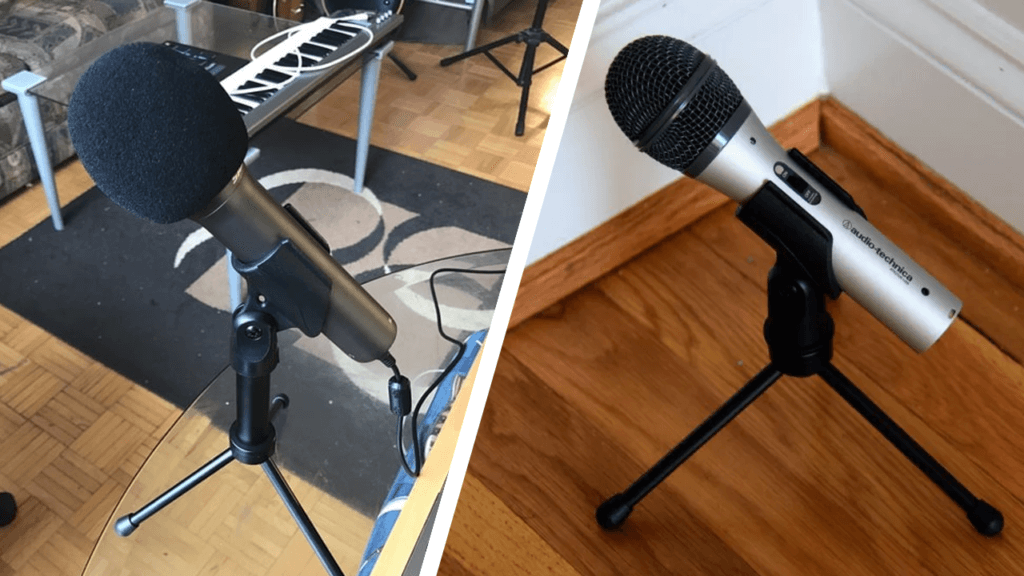Samson Q2U vs ATR2100 - Comparison and Review
Mar 14, 2022
Looking for a comparison and review of the Samson Q2U vs ATR2100? If so, you've come to the right place.
The Samson Q2U and Audio-Technica ATR2100 are both very similar microphones. They're typically recommended for beginners, and they have similar specifications and features. But not everything with these microphones is exactly the same.
In this article, you will learn:
ATR2100 vs Samson Q2U
Which One Is Best?
Read on and learn whether the Q2U or ATR2100 is the superior microphone.
ATR2100 vs Samson Q2U
The ATR2100 and Q2U are often compared to each other because they look similar and have similar features. However, there are some minor differences between them. Depending on your needs, these minor differences might have an impact on the mic you choose.
ATR2100

For many years, the ATR2100 flew under the radar as a decent budget microphone. In recent years, however, it has started to gain more recognition, and it is now suggested to many content creators. But is this mic as good as people say?
The ATR2100 is a great microphone- especially for the price. You will have a difficult time finding a microphone that is capable of producing such high-quality audio recordings that is in this price range.
This mic comes equipped with USB and XLR outputs, which means it can be used via USB or with an audio interface. Since this is the case, it's a great investment, as to upgrade your audio setup, you will not need to purchase another microphone.
Something to keep in mind is that the stand that comes with this product is less than ideal. You will need to purchase a different stand or boom arm to be able to record comfortably and easily.
Specifications and Features:
- Polar Pattern: Cardioid
- Frequency Response: 50-15kHz
- Dimensions: 7.9" x 2.2" x 10.62"
- Weight: 1.7lbs (0.77kg)
Pros
- USB/XLR outputs
- Build quality
Cons
- Included stand
- Difficult to access volume knob
Samson Q2U

In recent years, the Samson Q2U has become a popular microphone among YouTube content creators and podcasters. Many people claim that this microphone is the best budget option available. But is this the truth?
Put simply the Q2U is a phenomenal product. It comes equipped with all the specifications and features you need to record high-quality audio recordings, and it also has a great build quality.
Similar to the ATR2100, the Q2U has both USB and XLR outputs. This means that the microphone can be used via USB or an audio interface. Since this is the case, an audio setup can be upgraded without purchasing a new mic.
Unlike the ATR2100, the Samson Q2U captures more lows than mids or highs. The microphone has a warmer sound comparable to a radio show or podcast. Keep this in mind, as you may or may not want lows to be more prominent in your voiceovers.
Specifications and Features:
- Polar Pattern: Cardioid
- Frequency Response: 50-15kHz
- Dimensions: 13" x 4" x 10"
- Weight: 0.7lbs (0.32kg)
Pros
- USB/XLR outputs
- Ease of use
- Build quality
Cons
- Poor included stand
Which One Is Best?
At this point, you're probably wondering- which of these microphones is the best? Does one have clear advantages over the other? Should you go with the Samson Q2U or the Audio-Technica ATR2100?
Both the ATR2100 and Samson Q2U are great budget microphones. There isn't one that is better than the other. However, if you want a microphone that records warmer, deeper audio, the Q2U is your best option.
These products both feel and handle the same. They have essentially the same features and specifications, and many people cannot notice the difference between them when listening to voiceovers.
Keeping this in mind, both of these microphones are a good choice. If one is out of stock, purchase the other, or vice-versa. oBoth of these products often go on sale, so be sure to check the price of both of them before making a purchase.
Conclusion
You now know the main differences between the Samson Q2U vs ATR2100. While both microphones do look and feel similar, they capture audio differently, which leads to different sounding voiceovers.


